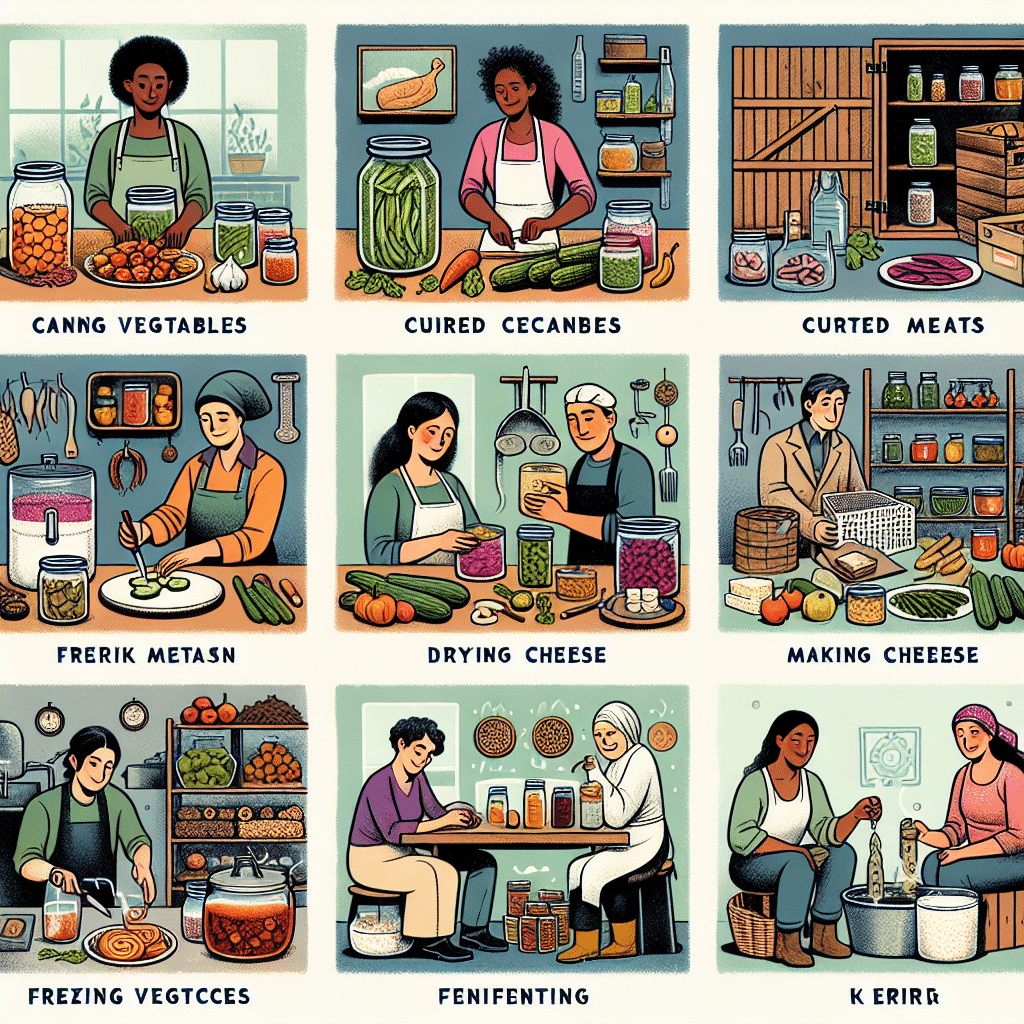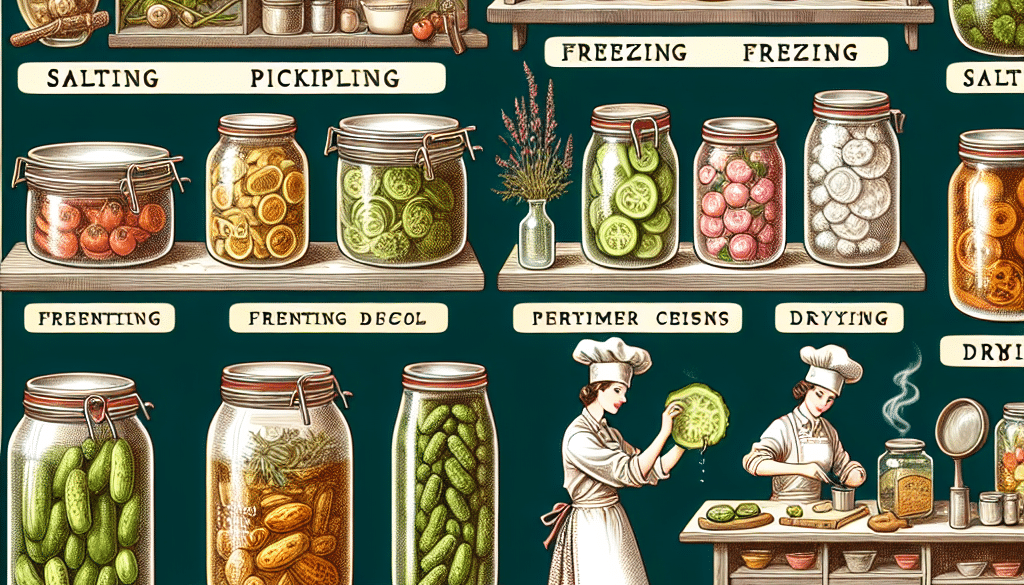Preserve & Savor: 8 Key Food Preservation Methods
-
Table of Contents
- Food Preservation Methods: 8 Essential Techniques to Know
- 1. Canning: Sealing Freshness for the Long Haul
- 2. Freezing: Nature’s Pause Button
- 3. Drying: The Art of Removing Moisture
- 4. Smoking: Infusing Flavor While Preserving
- 5. Pickling: The Power of Acidity
- 6. Fermenting: Harnessing Beneficial Bacteria
- 7. Salting: The Ancient Essense of Preservation
- 8. Vacuum Packing: Creating an Air-Free Environment
- Conclusion: Embracing Time-Honored Preservation Practices
- Enhance Your Diet with ETprotein’s High-Quality Protein Products
Food Preservation Methods: 8 Essential Techniques to Know

Food preservation is an ancient practice that has evolved over centuries, enabling humans to store food for longer periods and thus ensuring a stable food supply. With the advent of modern technology, food preservation methods have become more sophisticated, allowing us to keep food fresh, nutritious, and safe for consumption. In this article, we will explore eight key food preservation methods that are essential for anyone looking to extend the shelf life of their food while maintaining its flavor and nutritional value.
1. Canning: Sealing Freshness for the Long Haul
Canning is a method that involves placing foods in jars or cans and heating them to a temperature that destroys microorganisms and inactivates enzymes. This process also removes air from the container, creating a vacuum seal that prevents new microorganisms from entering and spoiling the food. Canning can be done at home using a water bath for high-acid foods like fruits and pickles, or a pressure canner for low-acid foods like vegetables and meats.
2. Freezing: Nature’s Pause Button
Freezing is one of the easiest and most convenient methods of food preservation. By storing food at 0°F (-18°C) or lower, the growth of microorganisms is halted, and chemical reactions that cause spoilage are slowed down significantly. Freezing preserves the texture, flavor, and nutritional value of most foods and is suitable for a wide range of products, including fruits, vegetables, meats, and prepared dishes.
3. Drying: The Art of Removing Moisture
Drying, or dehydration, is one of the oldest food preservation techniques. It involves removing water from food, which inhibits the growth of bacteria, yeasts, and molds that require moisture to thrive. Dried foods are lightweight, take up less storage space, and have a long shelf life. Sun drying, air drying, oven drying, and using a food dehydrator are all common methods of removing moisture from food.
4. Smoking: Infusing Flavor While Preserving
Smoking is a preservation method that combines drying with the application of smoke. The smoke contains compounds that have antimicrobial and antioxidant properties, helping to extend the shelf life of the food. Smoking is traditionally used for preserving meats and fish, and it also imparts a distinctive smoky flavor that is highly prized in many cuisines.
5. Pickling: The Power of Acidity
Pickling involves immersing food in an acidic solution, usually vinegar, or fermenting it in a salt brine to create an acidic environment. This high-acid environment prevents the growth of spoilage-causing microorganisms. Pickled foods include vegetables, fruits, eggs, and meats, and they often develop a tangy or sour taste that is both delicious and unique.
6. Fermenting: Harnessing Beneficial Bacteria
Fermentation is a process where natural bacteria feed on the sugar and starch in food, creating lactic acid. This not only preserves the food but also promotes the growth of beneficial bacteria, known as probiotics, which are good for the digestive system. Common fermented foods include yogurt, sauerkraut, kimchi, and sourdough bread.
7. Salting: The Ancient Essense of Preservation
Salting, or curing with salt, is a method that draws moisture out of food through the process of osmosis, making it inhospitable to microorganisms. Salt-cured foods are often dried or smoked for additional preservation and flavor. This method is commonly used for meats and fish, resulting in products like jerky, salt-cured ham, and salted cod.
8. Vacuum Packing: Creating an Air-Free Environment
Vacuum packing removes air from a package before sealing it. This method significantly reduces the oxygen level, slowing down the growth of aerobic bacteria and fungi, and preventing the evaporation of volatile components. Vacuum-packed foods can be stored in the pantry, refrigerator, or freezer, depending on the type of food and desired shelf life.
Conclusion: Embracing Time-Honored Preservation Practices
Each of these eight food preservation methods offers unique benefits and can be used in various combinations to achieve the desired results. Whether you’re a home cook looking to extend the life of your garden’s bounty or a food enthusiast exploring traditional culinary techniques, understanding and applying these methods can help you preserve your food’s freshness, flavor, and nutritional value. By mastering these techniques, you can reduce food waste, save money, and enjoy your favorite foods year-round.
Enhance Your Diet with ETprotein’s High-Quality Protein Products
After learning about the various ways to preserve food, it’s also important to consider the nutritional content of what we consume. ETprotein offers a range of high-quality protein products that can complement your preserved foods and contribute to a balanced diet. Their organic and non-GMO protein powders, such as rice, pea, and pumpkin seed proteins, are perfect for adding to smoothies, baked goods, and other recipes. With ETprotein’s commitment to purity and quality, you can trust that you’re incorporating the best protein sources into your meals.
About ETprotein:
ETprotein, a reputable protein and L-(+)-Ergothioneine (EGT) Chinese factory manufacturer and supplier, is renowned for producing, stocking, exporting, and delivering the highest quality organic bulk vegan proteins and L-(+)-Ergothioneine. They include Organic rice protein, clear rice protein, pea protein, clear pea protein, watermelon seed protein, pumpkin seed protein, sunflower seed protein, mung bean protein, peanut protein, and L-(+)-Ergothioneine EGT Pharmaceutical grade, L-(+)-Ergothioneine EGT food grade, L-(+)-Ergothioneine EGT cosmetic grade, L-(+)-Ergothioneine EGT reference grade and L-(+)-Ergothioneine EGT standard. Their offerings, characterized by a neutral taste, non-GMO, allergen-free attributes, with L-(+)-Ergothioneine purity over 98%, 99%, cater to a diverse range of industries. They serve nutraceutical, pharmaceutical, cosmeceutical, veterinary, as well as food and beverage finished product distributors, traders, and manufacturers across Europe, USA, Canada, Australia, Thailand, Japan, Korea, Brazil, and Chile, among others.
ETprotein specialization includes exporting and delivering tailor-made protein powder and finished nutritional supplements. Their extensive product range covers sectors like Food and Beverage, Sports Nutrition, Weight Management, Dietary Supplements, Health and Wellness Products, and Infant Formula, ensuring comprehensive solutions to meet all your protein needs.
As a trusted company by leading global food and beverage brands and Fortune 500 companies, ETprotein reinforces China’s reputation in the global arena. For more information or to sample their products, please contact them and email sales(at)ETprotein.com today.














